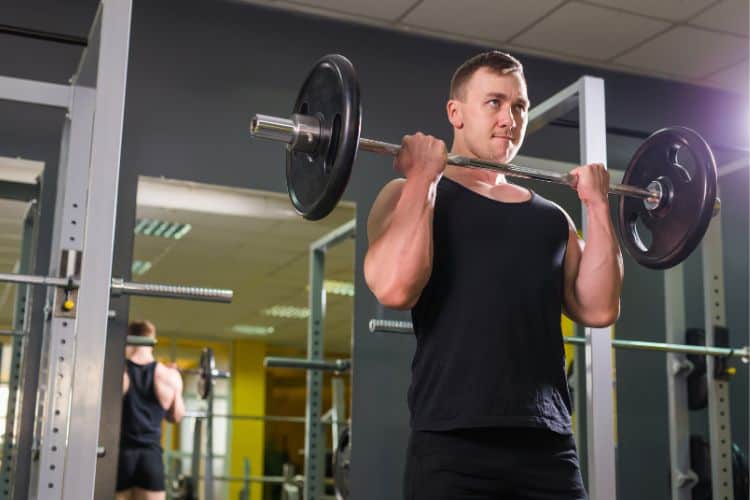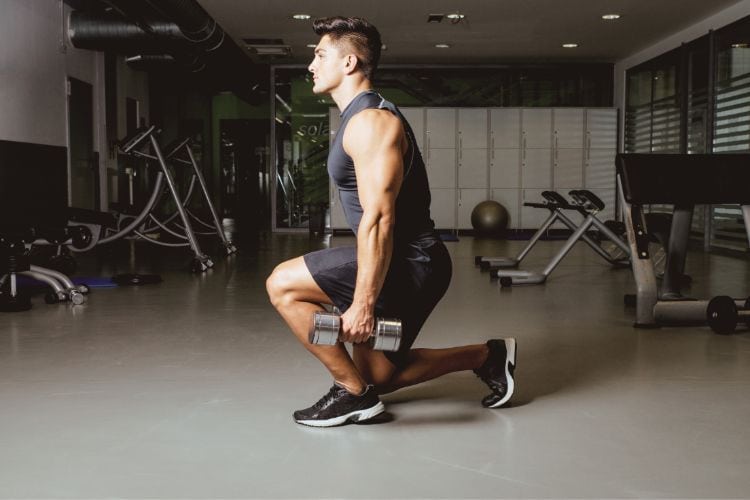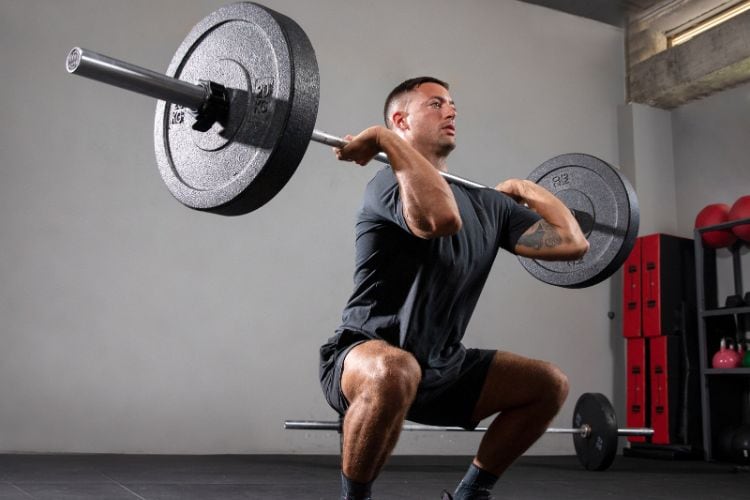
Triceps Dips Build Stronger Arms with Effective Workouts

Barbell Curls Build Bigger Biceps with Proper Form & Variations

30 Day Beach Body Workout Transform Your Body in One Month

Barbell Front Squat Build Strength Stability and Power
How To Get Bigger Calves With These Exercises

Having well-developed calves is not just about aesthetics—it’s also essential for functional strength, athletic performance, and injury prevention. However, many people struggle to grow their calves, even when they train regularly. That’s because the muscles are notoriously stubborn and require a focused and strategic approach to develop. In this guide, we’ll dive deep into the anatomy of the calves, the reasons they can be hard to grow, and the best workouts for building bigger, stronger muscles.
The Ultimate Guide to Workouts for Bigger Calves
Calf training is frequently neglected in many workout routines. This is often because calves are not seen as a “glamour” muscle like biceps or chest. Additionally, some people believe calf size is mostly determined by genetics. While genetics do play a role in shape and muscle fiber distribution, targeted training can still significantly improve calf size and strength.
Understanding Calf Anatomy
To train your calves effectively, you need to understand their anatomy. The calf is composed of two main muscles:
Gastrocnemius
The gastrocnemius is the larger, visible part of the calf muscle. It has two heads—medial and lateral—and gives the calf its shape. It’s responsible for explosive movements like jumping and sprinting. It is best activated with straight-leg exercises.
Soleus
The soleus lies underneath the gastrocnemius and plays a key role in postural stability and endurance. Since it’s primarily made up of slow-twitch muscle fibers, it responds well to high-volume training. It is best targeted with bent-knee exercises.
Principles for Growing Bigger Calves
To build bigger calves, you need more than just random sets of raises. Here are essential principles that make a difference:
1. Train With Frequency
Calves can handle high frequency due to their daily use in walking, running, and standing. Training calves 3–5 times a week is ideal for optimal growth.
2. Use Full Range of Motion
A full stretch at the bottom and a strong contraction at the top of every rep is key. Partial reps won’t deliver the same muscle activation and growth stimulus.
3. Mix Up Reps and Load
Train with heavy weight in the 6–10 rep range for strength and muscle density, and lighter weight in the 15–25 rep range for hypertrophy and endurance.
4. Prioritize Time Under Tension
Slower reps, controlled negatives, and pauses at the top of the movement increase time under tension, stimulating more muscle fibers for growth.
Best Workouts for Bigger Calves
The following exercises are divided into straight-leg movements (which primarily target the gastrocnemius) and bent-knee movements (which emphasize the soleus). A balanced program will include both.
Standing Calf Raise
How to Do It:
Stand on a raised platform or step with your heels hanging off. Keep your knees straight. Raise your heels as high as possible, squeeze at the top, then slowly lower below the platform level.
Benefits:
This is the gold standard for targeting the gastrocnemius. You can do it with bodyweight, dumbbells, or on a standing calf raise machine.
Tips:
- Pause at the top for 1–2 seconds.
- Lower slowly to feel the stretch.
- Perform 3–4 sets of 10–15 reps.
Seated Calf Raise
How to Do It:
Sit on a bench or machine with a weight on your thighs. Keep your knees bent at 90 degrees. Raise your heels as high as you can, pause at the top, then slowly lower.
Benefits:
This exercise isolates the soleus muscle due to the bent-knee position. The soleus plays a major role in calf thickness and endurance.
Tips:
- Use moderate weight and high reps.
- Keep your heels in control—don’t bounce.
- Perform 4 sets of 15–25 reps.
Donkey Calf Raise
How to Do It:
Bend at the hips while keeping your legs straight. With resistance on your lower back (via a machine or training partner), raise your heels and contract the calves.
Benefits:
Donkey raises provide a great stretch and hit the upper calves hard. They are old-school but highly effective.
Tips:
- Hold the stretch at the bottom for 2 seconds.
- Focus on peak contraction.
- Perform 3 sets of 12–15 reps.
Leg Press Calf Raise
How to Do It:
On a leg press machine, place your toes on the lower edge of the platform. Push through the balls of your feet to raise your heels, then lower slowly.
Benefits:
This allows you to load heavy while maintaining good form. You can easily adjust foot positioning to target different calf areas.
Tips:
- Don’t let your heels come fully off the sled.
- Avoid locking your knees.
- Perform 4 sets of 10–20 reps.
Smith Machine Calf Raise
How to Do It:
Stand under a Smith machine bar with a block under your toes. With the bar on your traps, raise and lower your heels in a controlled motion.
Benefits:
This provides stability, allowing for a strong focus on form and time under tension.
Tips:
- Use a slow tempo: 2 seconds up, 2 seconds down.
- Pause at the top and bottom.
- Perform 3–4 sets of 12–15 reps.
Calf Jumps
How to Do It:
Stand upright and explosively jump using only your calves, keeping your knees straight throughout.
Benefits:
This builds explosive strength and power in the gastrocnemius. It’s a great bodyweight finisher or warm-up.
Tips:
- Jump high using just your calves.
- Land softly and rebound quickly.
- Do 3 sets of 15–20 reps.
Farmer’s Walk on Toes
How to Do It:
Hold heavy dumbbells and walk on the balls of your feet for distance or time.
Benefits:
This combines strength, balance, and endurance, engaging both muscles while improving stability and posture.
Tips:
- Keep your core tight.
- Walk for 30–60 seconds.
- Do 2–3 rounds.
Sample Weekly Calf Workout Plan
Here’s a sample calf routine you can add to your weekly training split.
Day 1 – Strength Focus (Gastrocnemius)
- Standing Calf Raise – 4 sets of 8–10 reps (heavy)
- Donkey Raise – 3 sets of 12 reps
- Jumps – 3 sets of 20 reps
3 – Volume Focus (Soleus)
- Seated Raise – 4 sets of 20–25 reps
- Leg Press Raise – 3 sets of 15 reps
- Toes-Elevated Farmer’s Walk – 3 rounds, 40 seconds each
5 – Mixed Stimulus
- Smith Machine Calf Raise – 4 sets of 15 reps (tempo: 2 up, 2 down)
- Standing Raise (Bodyweight) – 3 sets to failure
- Jump Rope – 3 minutes continuous
Additional Tips for Calf Growth
Stretch Regularly
Tight calves can limit your range of motion and hinder your workouts. Stretch post-workout or daily using wall stretches and foam rolling.
Focus on Mind-Muscle Connection
Don’t just go through the motions. Actively squeeze and engage your calves with every rep. This connection improves muscle fiber recruitment.
Don’t Skip Calves on Leg Day
It’s easy to avoid exercises when you’re already tired from squats and lunges. Make a priority by training them first or on separate days.
Use Progressive Overload
Gradually increase the weight, reps, or time under tension over time. Track your progress to ensure you’re pushing your muscle to grow.
Consider Genetics, but Don’t Blame Them
While your insertion points and muscle bellies are genetically fixed, you can still maximize what you’ve got with consistent and strategic training.
Building Bigger Calves Takes Commitment
Calves are one of the most stubborn muscle groups to grow, but with the right plan, consistent effort, and smart programming, you can build impressive lower legs. Combine straight-leg and bent-knee exercises, vary your rep ranges, focus on form, and train with intensity. Don’t neglect frequency—your calves are used to daily stress, so you’ll need to do more than a few half-hearted sets to shock them into growing. Commit to a solid routine and watch those skinny calves transform into thick, powerful pillars of strength.
Most Recommended
Subscribe to our Newsletter
Stay up to date on the latest men’s health, fitness and lifestyle trends and tips.
About Us
Men’s Fit Club was started with the goal of empowering men to get the most out of their lives. This meant going beyond exercise and diet tips to really address the broad range of issues that men face on a daily basis – topics like recreation, finding love, sexual health and even sound fashion advice.
Quick Links
© COPYRIGHT MEN'S FIT CLUB 2025. All Rights Reserved

